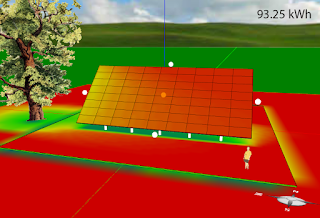 |
| Fig. 1 Aerial view of PMA (courtesy of Borrego Solar) |
 |
| Fig. 2 The polygon tool for drawing land parcels |
The
Palmer Metropolitan Airfield (PMA) solar farm (Figure 1) is the first and, at 6 MW, the largest Massachusetts
Department of Energy Resources qualified brownfield project under the
SREC II solar energy incentive program. The solar farm consists of 20,997 solar panels of three different types (5,161 Suniva, 13,851 Yingli, and 1,985 Canadian Solar), connected by 74 SMA string inverters. It is expected to produce an estimate of 8.5 GWh annually, enough to power 1,000 homes and offset 4,000 tons of carbon dioxide every year -- according to
this news source. The PMA solar farm was engineered by our partner,
Borrego Solar, the third largest company in the commercial solar market in the US.
 |
| Fig. 3 The Automatic Layout Wizard for solar rack arrays |
The PMA solar farm is the first test of
Energy3D's capacity of seriously designing utility-scale (greater than 1 or 5 MW, depending on
your point of view) photovoltaic solar power plants. This design capacity was enabled by three critical new features that were added only recently to Energy3D (V6.2.2): 1) A tool to draw polygons that represent parcels of land for solar farms; 2) a tool to automatically generate solar panel and rack array layouts within selected parcels of land; and 3) accelerated graphical user interface and numerical simulation to handle 10,000+ solar panels (which
I have blogged earlier this month).
 |
| Fig. 4 The result of the Automatic Layout Wizard |
Since Energy3D can import an Earth view image from Google Maps, you can directly draw polygons on top of the image to trace the parcel of land for designing your solar farm (Figure 2). Note that if you have multiple parcels of land that are separate from one another, you may have to use multiple foundations in Energy3D as each foundation is allowed to have one and only one polygon for the time being.
 |
| Fig. 5 Heat map representations of output in four seasons. |
 |
| Fig. 6 Annual yield vs. tilt angle |
As soon as you are all set with your land plans, you can use the Automatic Layout Wizard of Energy3D to add solar panel rack arrays (Figure 3). This wizard will automatically generate the array layout within the selected land parcel and assign properties to the solar panels based on the parameters of your choice. For instance, you can select how many rows of solar panels you want to have on each rack (I picked four because that is what Google Maps shows about the setting in PMA). Figure 4 shows the result of applying the Automatic Layout Wizard to populate the three subfields of the PMA solar farm.
 |
| Fig. 7 Monthly yields vs. tilt angle |
After the layout is done, you can always revise the field. You can drag any rack to resize or move it, delete it, copy and paste it, or add a new rack. The Automatic Layout Wizard is not the only way to add solar panel arrays. It is just a super fast way to add thousands of solar panels at once -- without the wizard, it would have been too time-consuming to manually add solar panel racks one by one. The solar panel field is always editable after a layout is applied.
Let's now check how close our model is to reality. The total number of solar panels of our model is 21,064 -- only 67 more than that of the real PMA solar farm (I had no information about the exact types of solar panels deployed in PMA, so I guessed and selected two different sizes 0.99m x 1.65m and 0.99m x 1.96m for different subfields).
In terms of the annual output, Energy3D predicts approximately 9.6 GWh, about 12% higher than the estimated output of 8.5 GWh by Borrego Solar. I currently do not have access to the real operational data, though.
Having created a computer model allows us to experiment with it to study how to optimize the design. For example, we can easily change the tilt angles of the arrays and investigate how the annual yield is affected. Figure 6 shows that a tilt angle close to the latitude (42 degrees) seems to result in the highest overall annual output.
But the total annual output is not necessarily the only criterion. Sometimes, it is necessary for solar companies to consider load balancing to guarantee stable outputs throughout the year (assuming that we want to minimize the use of base load from burning fossil fuels). It is, therefore, interesting to also take a look at the outputs across 12 months of a year. Figure 7 suggests that a smaller tilt angle will produce peak power in the summer, whereas a larger tilt angle will produce peak power in early fall. If the demand of electricity in the summer is higher than that in the fall, it may be more lucrative to position solar panels at a lower tilt angle.













